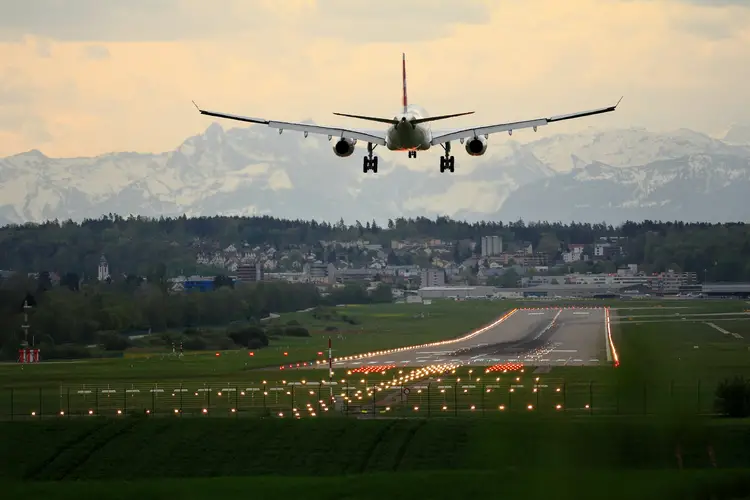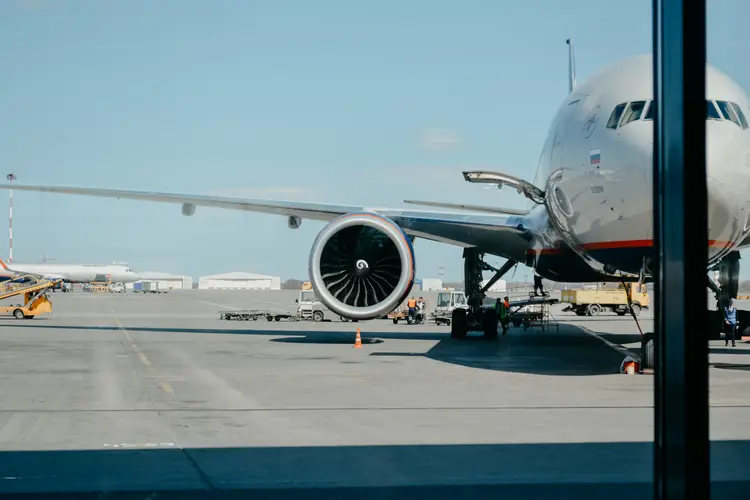
Just when you’ve found the perfect house, you realise it’s right near an airport. But the question is; should you buy the house or give it a miss?
There are a number of factors to consider when buying a house near an airport, which include noise pollution, air pollution and the effect on house prices. Which is why you need to consider carefully whether you should buy a house near an airport.
Only buy a house near an airport once you’ve considered the health risks associated with the additional pollution found near an airport, especially downwind and on the flight path. You should also check if you’re going to be happy with the additional noise pollution experienced near airports.

Is it bad to live close to an airport?
Research into 12 Californian airports shows that it is bad to live close to an airport. It revealed a 17% increase in asthma attacks and a 9% increase in heart problems for those that live within 10km (6.2 miles) from an airport as pollution increased when planes taxi or idle for longer. (Ref: Airports, Air Pollution, and Contemporaneous Health).
Also, a recent study has found that women who live within 15km (9.32 miles) of incoming flight paths and downwind of LAX were 14% more likely to experience preterm birth. Premature new born babies are at risk of health problems, which include heart, lung and brain development issues as well as vision and hearing impairments. (Ref: University of Washington).
How far should a house be from an airport?
You should live at least 10 miles away from an airport or upwind from it, as it has been found that particulate levels 10 miles downwind from LAX airport in Los Angeles were double the levels further away. But this pollution increased 4-5 fold within 8-10km (5-6 miles) downwind of the same airport. (Ref: ACS Publications).

Do Airports affect house prices?
Airports do affect house prices, especially if the house is directly on the flight path. This is particularly on the flight path in the direction of take-off of the aircraft.
These are empirical findings in relation to the effect of airports on lowering property values:
- Amsterdam Schiphol Airport: A house price reduction of 0.77% per 1dB increase in aircraft noise.
- Atlanta Hartsfield-Jackson International Airport: Houses in areas exposed to a day-night sound noise levels of 70-75 dB sell for 20.8% less than houses in areas with a noise level below 65 dB.
- Zurich Airport: Houses in areas with noise levels of 65 dB and above sell for approximately 2.4% less than homes located below this threshold.
- Chicago O’Hare Airport: The values of houses near the airport subject to noise levels from 65 dB are about 9% lower than comparable houses in less noise polluted areas.
- The USA in general: The effect of airport noise on US housing prices is 0.51-0.67% per additional decibel.
- Canada in general: The effect of airport noise on Canadian housing prices is 0.8-0.9% per additional decibel.
- UK in general: The effect of airport noise on UK housing prices is 0.48% per additional decibel.
- Australia in general: The effect of airport noise on Australia housing prices is 0.48% per additional decibel.
- Berlin Tempelhof Airport: Houses within the Tempelhof air corridor sell at approximately 9% discount due to noise pollution.
- Raleigh–Durham International Airport in North Carolina: There’s a 2.9% discount on house prices in the 65-70dB noise zones.
- It is also noted that on the announcement of a new airport hub at Greensboro Airport in North Carolina, there was an increased house price discount of 9.2% after it was announced.
(Ref: Health Impacts of Noise Pollution Around Airports: Economic Valuation and Transferability).

What to do before buying a house near an airport
Before you put in an offer on a house near an airport, make sure you visit the house at different times of the day.
But you should also plan a visit when the wind changes direction from the prevailing wind direction, as planes will often take-off in the opposite direction when the wind shifts.
I have done some calculations myself using a very handy sound calculator, which is linked to at the bottom of the following table.
Don’t worry about the science bit and terms like “inverse square law“, as I don’t understand this either. The most important thing for you is that you should be able to read and understand the numbers in the table.
I was shocked by the distance at which you will still be able to hear a jet-engine aircraft taking off when it’s at 120dB within 15 metres of the plane at take-off.

Airport noise levels and how decibels reduce with distance from the airport using sound attenuation and the inverse square law
| Distance from dB measuring point | Take-off 120dB at measuring point | Landing 80dB at measuring point |
|---|---|---|
| 250m (0.16m) | 95.6dB | 55.6dB |
| 500m (0.31m) | 89.5dB | 49.5dB |
| 1000m (0.62m) | 83.5dB | 43.5dB |
| 1.5km (0.93m) | 80dB | 40dB |
| 2km (1.24m) | 77.5dB | 37.5dB |
| 3km (1.86m) | 74dB | 34dB |
| 4km (2.5m) | 71.5dB | 31.5dB |
| 5km (3.1) | 69.5dB | 29.5dB |
| 10km (6.21m) | 63.5dB | Very low and won't be able to hear |
| 15km (9.32m) | 60dB | Very low and won't be able to hear |
| 20km (12.43m) | 57.5dB | Very low and won't be able to hear |
| 30km (18.64m) | 54dB | Very low and won't be able to hear |
| 40km (24.85m) | 51.5dB | Very low and won't be able to hear |
| 50km (31m) | 49.5dB | Very low and won't be able to hear |
| 60km (37m) | 48dB | Very low and won't be able to hear |
1. These calculations have been done with the help of the calculator tool on this website: Sound Attenuation – Inverse Square Law.
2. The R1 distance (i.e. where the sound is recorded at the first level of decibels) was set as 15 metres from the plane.
3. What this calculation doesn't take account of is topography and wind direction and speed.
4. Aircraft noise is also affected by humidity, air density and cloud cover.
5. It is assumed that the noise of a jet plane is 120dB when taking off and 80dB when landing at around 1,000 feet.
6. I admit I know nothing about the invest square law, and nor do you need to understand this either.
7. dB = decibels..

Use the following table of how loud decibel levels are when compared to similar sounds. This will help when you look at the above table of distance from airport noise levels.
How loud decibel levels of noise are:
| How loud is: | Similar sound levels | Sleep effects | Level of irritation |
|---|---|---|---|
| 30 decibels | 35 decibels is whisper quiet | 30dB is potential for awakening, body movements, arousals and sleep disturbance, but is only just above the level of 25dB where there's little to no effect on sleep. | 30dB is very low level noise. |
| 40 decibels | 40dB is the level of a quiet library | 40dB is potential for awakening, body movements, arousals and sleep disturbance. | 40dB is very low level noise. |
| 50 decibels | 50dB is the same level of sound as a working refrigerator or even a car driving past. | 45-50dB can cause health affects and have been observed and noise at this level may affect most people. | Acceptable to live with. |
| 55 decibels | 55dB is similar to a percolating coffee-maker. | 55 dB is considered dangerous levels for public health, increasing annoyance and sleep disturbances. | Acceptable to live with. |
| 60 decibels | 60dB is the normal level of a human voice and normal conversation or machinery or the sound of a dishwasher. | 60 dB is considered dangerous levels for public health, increasing annoyance and sleep disturbances. | Acceptable to live with, but could get irritating after prolonged periods |
| 65 decibels | 65dB would be equivalent to the sound of laughter. | 65dB would be difficult to sleep through. | Would be quite irritating. |
| 70 decibels | 70dB is equivalent to a TV set on loud or a vacuum cleaner. | 70dB would be very difficult to sleep through. | 70dB would be classed as irritating. |
| 75 decibels | 75dB would compare to a busy restaurant. | 75 dB would be very difficult to sleep through. | 75dB would be regarded as constant sound. |
| 80 decibels | 80dB is equivalent to an alarm clock, freight traffic or the sound of a doorbell. | 80 dB would be almost impossible to sleep through, which is why an alarm clock is set at this level. | 80dB would be regarded as unpleasant. |
| 100 decibels | 100dB is equivalent to the sound of a snowmobile or an MP3 player at full volume. | 100dB would be impossible to sleep through. | 100dB is very loud and dangerous for over 30 seconds. |
| 110 decibels | 110dB is equivalent to a concert or a car horn. | 110dB would be impossible to sleep through. | 110dB is very loud and dangerous for over 30 seconds. |
| 120 decibels | 120 dB is the equivalent to a jet plane taking off. | 120dB would be impossible to sleep through. | 120dB is uncomfortably loud and dangerous over 30 seconds. |
| 130 decibels | 130dB is the equivalent of a jackhammer or an ambulance. | 120dB would be impossible to sleep through. | 120dB is painfully loud and dangerous without hearing protection and should be avoided. |
The information for the above table is thanks to a combination of information from the following websites and references:
1. Alpine Hearing Protection.
2. Early Bird by Amerisleep.
3. Audiology.
What are the pros and cons of living near an airport?
As with anything, there are always pros and cons to consider. As far as buying a house near an airport goes, the pros and cons include.
Pros of buying a house near an airport
- Houses can be cheaper so you get more house for your money.
- A quick commute if you live near an airport and work there.
- Great if you love plane spotting.
- Provides a number of jobs for the local community.
- If you are a frequent flyer, living near an airport will be an advantage.
- Airports are close to other transport links making it easier to commute or travel to different locations.
- Fortunately, airports close during the night.
Cons of buying a house near an airport
- Air pollution can be damaging to health, especially within 10-15km (6.2-9.32 miles) downwind of the airport.
- Noise pollution can be damaging to mental health.
- Noise pollution will affect sleep patterns.
- Traffic congestion and increased commute times for local people.
- Flights start early in the morning, so if you’re not an early riser this is likely to wake you.
- Flights run on into late evening, which means if you are early to bed the noise will keep you awake.

Why do people live near airports?
Many people live near airports because they work at the airport for an airline or as support staff for the many businesses that operate out of an airport. But you also find executives who travel for work find it convenient to live next to an airport too.
Is it safe to live near a small airport?
It’s no safer to live near small airports than near large airports, as populations tend to live closer to small regional airports meaning they are closer to the pollution. Lead pollution from small planes is a problem, as it affects the nervous system, kidney function and the cardiovascular system.
Final thoughts about whether you should you buy a house near an airport
If you buy a house near an airport, it’s likely you will get used to the noise, so long as the house isn’t too close or directly on the take-off flight path.
Also, consider the airport the house is near to. For example a house near to Heathrow Airport or Gatwick Airport will be different to one near a smaller airport like Southampton Airport. Or LAX airport vs a smaller regional Californian airport will have different noise levels.
Other houses where noise levels are a consideration are cluster houses, also known as quarter houses. You might like to read more about why cluster houses can be noisier than semi-detached or terraced houses and is a cluster house noisy?
Types of planes at the airport will make a difference to noise levels
The type of planes that take off and land at the airport will make a huge difference to noise levels. For example, the large jet planes are very noisy vs the smaller passenger turbo-prop planes will be quieter.
You should also take account of where you currently live and the noise levels you are used to. If these are current lower and below 55dB, buying a house near an airport will affect you more than if you are moving from near another airport or next to a noisy highway.
Before you buy a house near an airport, check into whether there are any planned expansions of additional terminals or runways at the airport, this will increase noise and air pollution.
Consider house price increase in the future
Also consider house price rises and how this will be affected by the close proximity to an airport.
Noise pollution from airports should reduce as aircraft engine noise reduces with technology improvements. The same goes for air pollution too, as jet engine manufacturers strive for greener engines.
But as an example, if you purchase a house that wasn’t near to an airport for £250,000 and in an area where general noise levels are 54dB. If house prices increase by 20% during your ownership, this house will then be worth £300,000, which is an increase of £50,000.
But a similar house near to an airport, and assuming this is in the UK and there’s a 0.48% reduction per decibel increase and the house is within 74dB noise levels, this house would be priced at £226,000 to begin with (i.e. 20dB increase from 54dB = 20 x 0.48 = 9.6% reduction, which is £24,000).
Assuming decibel levels remain the same during your ownership, the increased price would be £271,200 (i.e. £226,000 increased by 20%). This is an increase of £45,200 instead.
Finally, you may also like to discover how you could save you up to £71,475 when you buy your next house if it would originally cost £350,000. Alternatively, if you propose to buy your next house for £250,000, the saving could be up to £51,852 instead.
To find out more, plus to get hold of my free mortgage savings calculator tool, please take a look at my video course about how to sell your house in under 2 weeks for more money.
You may also like to discover if it’s okay to buy a house near a bad estate too.
I hope you’ve enjoyed this article about should you buy a house near airport
If you’ve enjoyed this article about “should you buy a house near an airport” please share it on your favourite social media site.
Also, if you have any questions, please feel free to comment below too. Please also share any of your experiences with properties you’ve bought. Alternatively, if you need more help, please feel free to contact us on our contact us page here. Or join the discussion and ask your question in the property forum.




